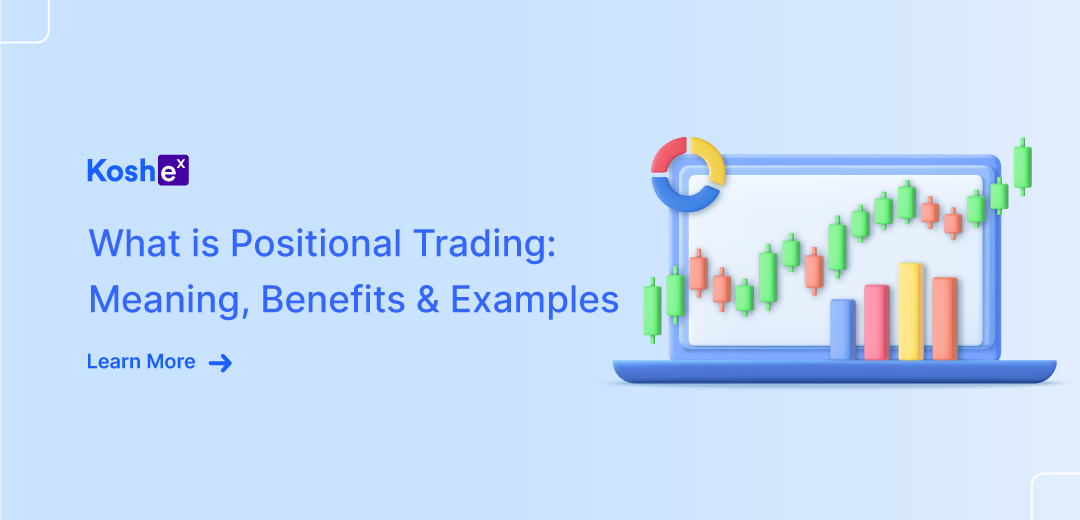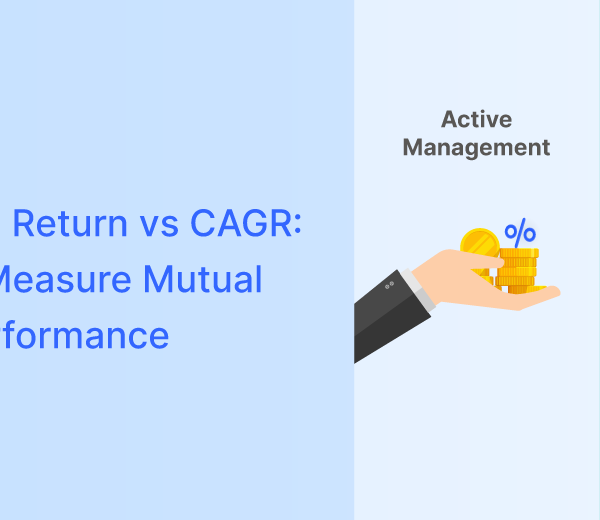Every person who invests in the stock market follows a different strategy to grow their wealth and achieve financial success. But if you are too busy to keep up with the daily fluctuations of the stock market and still want to reap the benefits, positional trading might be the right strategy for you.
In this blog, we will discuss what positional trading is, how it works, its benefits, and examples.
What Is Positional Trading?
Positional trading is a type of trading strategy where an investor holds a position (i.e. invests in a stock, bond, commodity, or currency) for a longer time, typically ranging from weeks to several months or even years. Unlike day trading, which focuses on quick intra-day profits, positional trading aims at capturing large price movements over an extended period.
The focus of the investor in this strategy is to look for a trend to emerge and stay invested for the long term to reap the best possible benefits. Position traders are like investors rather than any other traders in the market. Only passive investors hold and buy stocks for a time period more than position traders. The basis of their decision is if a certain trend may come into effect or if a theme is materialising in the market.
Here is an example of positional trading. Let’s say a trader believes that the stock price of ABC Company will rise over the next few years. The trader comes to this conclusion after studying the company’s financial performance and doing their analysis. In 2020, during the market crash due to the pandemic, the trader bought shares of ABC company at around ₹1,200 per share. By mid-2023, the stock price had risen to ₹1,500 per share due to the company’s expansion in various sectors. This has earned the trader a 100% return.
Also Read: Tips For Maximising Returns On Mutual Fund
How Positional Trading Works?
Identifying Market Trends – Positional traders depend heavily on technical and fundamental analysis to find out long-term market trends. They typically look for stocks or assets that are in the early stages of a trend, whether bullish or bearish.
Entry Points – Once the trader identifies a potential trend, they will look for the right moment to enter the trend. This might be when a stock breaks a significant resistance level, or when its fundamentals (like earnings or revenue growth) indicate potential upside.
Holding The Position – Once the trade is made, the trader holds the position for an extended period and waits for the trend to play out. This could be weeks, months, or even years, depending on how strong the market trend is and how long the trader expects it to last.
Exit Strategy – Positional traders usually have predefined exit strategies. These may include booking profits when a certain price target is hit or exiting when the market trend reverses or a stock hits a stop-loss point.
What Are The Strategies Of Positional Trading?
Since positional trading involves holding stocks for a long period, here are some strategies that help investors make the best decisions.
Following Historical Trends – Like most trading strategies, positional trading also involves analysing the historical trends of the market to get a better understanding of positions. The only difference is that long-term trends are followed in the case of positional trading.
Investing In Growth Assets – This strategy focuses on positions that have a very high potential for growth in the future. The aim here is to identify companies that are built on strong foundations and invest in them early, betting on their eventual exponential growth over a relatively longer period.
Investing In Undervalued Assets – This strategy focuses on assets or stocks that have been undervalued in the market and can be purchased at lower prices. This helps improve profit margins at a later date.
Momentum-Based Trading – This strategy deals with buying stocks that have a good upward momentum and selling them only when that momentum begins to stagnate.
How Are The Trends Identified?
Identifying trends is an important aspect of positional trading, as it allows traders to enter trades at the right moment and maximises potential profits.
Let’s take a look at how these trends are identified.
Moving Averages – Moving Averages help to smooth out price data and identify trends. Trades typically use longer-term averages, such as the 50-day or 200-day moving average to determine the long-term trend.
Uptrend: When the stock price is above its moving average.
Downtrend: When the stock price is below its moving average.
Trendlines – Drawing trendiness connects the series of higher lows (in an uptrend) or lower highs (in a downtrend). A break above or below a trend line can signal the start of a new trend.
Relative Strength Index (RSI) – The RSI oscillates between 0 and 100 and is used to identify overbought or oversold conditions. Traders use RSI to identify bullish or bearish divergences, which can signal a trend reversal.
Also Read: Equity Mutual Funds
Moving Average Convergence Divergence (MACD) – MACD is a trend-following momentum indicator that shows the relationship between the two moving averages. Traders use the MACD to identify trend changes and to confirm a trend’s strength.
Support and Resistance – The asset price movement is seen from the support and resistance lines. Support is the lower limit of the stock price and resistance is the upper limit. Historical data is used as a benchmark to identify the support and resistance levels of stock. When a breakout happens in the market, the support line becomes the resistance and vice versa.
Earnings Growth – Companies showing consistent earnings growth are likely to see upward price movements over time.
Revenue Trends – A company with steadily growing revenues over multiple quarters signals potential for long-term growth, which could indicate a bullish trend.
Bollinger Bands – Bollinger Bands are a volatility indicator that uses a moving average and two standard deviations to create a band around the price.
Fibonacci Retracement – Fibonacci Retracement is a technical analysis tool to identify potential support and resistance levels in a trend. Traders use the Fibonacci levels to identify potential trade entry and exit points.
Breakout Strategy – In this strategy, the investor delays entering the buy position for a stock till the resistance i.e. the upper limit of the stock price is broken. However, the investor will enter a sell position if the support i.e. the lower limit of the stock price is broken.
Range Trading – When there is no specific trend that can be identified, investors trade using a range trading strategy. It helps to identify the assets that are overbought and oversold. The investor sells and buys these assets respectively.
Sentiment Indicators – Tools like the Volatility Index (VIX), often called the “fear gauge,” can signal changes in market sentiment. When VIX rises, it suggests heightened fear, potentially signalling a bearish trend, while a declining VIS may indicate market optimism and a bullish trend.
News Sentiment – Tracking news and social media can give insights into how traders and investors feel about a stock, industry, or market. An overwhelming positive or negative sentiment can indicate potential trends.
Interest Rates – When central banks lower interest rates, it often leads to an upward trend in the equity market as borrowing becomes cheaper. This can fuel business expansion and consumer spending.
Sector Rotation – Certain sectors outperform others during specific economic phases. For example, technology stocks often surge during periods of economic expansion, while defensive sectors like utilities might gain during recessions. Traders identify these sector trends to allocate capital accordingly. For example, if a trader notices that renewable energy is gaining government support globally, they might position themselves in stocks related to wind, solar, or battery technology, expecting a long-term bullish trend.
What Are the Benefits Of Positional Trading?
Less Time-Consuming – Positional trading is less time-consuming compared to day trading or swing trading. Since trades are held for a longer time frame, traders don’t need to constantly monitor market movements every day. This makes it suitable for individuals who don’t have much time but still want to engage in trading.
Potential For Higher Returns – Positional traders often aim to capture large price movements. By identifying and capitalising on major market trends, they have the potential to earn significant profits.
Fewer Transactions, Lower Costs – Since the number of trades executed is much lower in positional training when compared to day trading or short-term strategies, traders would incur lower transaction fees. Traders will also witness reduced slippage (the difference between the expected price of a trade and the actual price at which the trade is executed). This can considerably impact overall profitability.
Aligned With Market Cycles – Positional traders are often able to align with the market’s broader economic cycles. Since they focus on long-term trends, they can make informed decisions based on macroeconomic factors such as interest rate changes, inflation data, and global economic conditions. This strategy works particularly well during strong bull or bear markets.
Less Stress – Since trades are not made frequently and are typically based on long-term trends, positional trading can be less stressful than strategies that require constant monitoring and rapid decisions. Positional traders can adopt a more patient approach, thus avoiding the emotional rollercoaster of short-term market fluctuations.
Also Read: Types Of Mutual Fund Schemes
What Are The Challenges Of Positional Trading?
Market Volatility – Even though positional traders may not be affected by short-term price movements, large market swings or unexpected events (like geopolitical issues or pandemics) can affect long-term trends. So, traders should have a good risk management plan to protect their positions from sudden plunges.
Tied Up Capital – Positional trading often requires holding a position for months or years. This means the capital can be tied up for an extended period. This can be a problem if more lucrative opportunities arise in other areas of the market.
Patience – If a stock or asset doesn’t perform as expected, it can test the patience of the trader. Hence, it is important to stick to a well-crafted trading plan and not make impulsive decisions based on short-term noise.
Positional Trading – The Conclusion
Positional trading is an excellent strategy for those who prefer a long-term approach to trading and have the patience to wait for significant market trends to unfold. When you combine technical and fundamental analysis, potential traders can capitalise on large price movements while avoiding the stress and time commitment of short-term trading strategies.
If you wish to invest in Mutual Funds and Digital Gold and track your EMIs, and PF, you can download the Koshex app for free today. Manage and grow your money like a professional with our app. Sign up now!
Frequently Asked Questions (FAQs)
What is the difference between positional trading and investing?
Positional trading is more active and focuses on timing trades based on market trends. Investors typically adopt a buy-and-hold strategy, focusing on the fundamental value of stocks or assets over very long periods (often years or decades), with less regard for short- or medium-term price movements.
Do I need to use stop-loss orders in positional trading?
Yes. Using stop-loss orders is an important risk management tool in positional trading. Since trades are held for longer periods, stop-loss orders can help protect against large, unexpected market downturns and prevent major losses.
Is positional trading less risky than day trading?
Positional trading can be less stressful and time-consuming compared to day trading, as it focuses on
long-term trends rather than short-term price volatility. However, it still carries risks such as market volatility, tying up capital for long periods, and potential loss if the trend reverses unexpectedly.









Leave a Comment